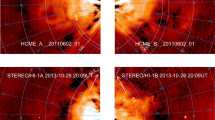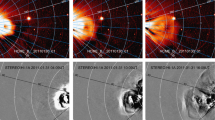Abstract
By now several methods have been proposed enabling to determine the kinematic characteristics of coronal mass ejections (CMEs) in 3D space. Many of these methods are based on using the triangulation technique and stereoscopic observations of the CMEs with two and more spacecraft. As a rule, these methods involve relatively complicated procedures. Nevertheless, there is a need for a simple technique to find 3D characteristics of a CME motion fairly quickly. Such a technique, in particular, will enable to estimate on which side of the Sun (front side or back side for an observer on the Earth) the CME emerged, as well as to efficiently solve a problem relevant for solar-terrestrial physics: to determine the time of the CME arrival into Earth’s orbit. Such a simple technique is proposed in this article. The technique comprises two stages. First, one identifies the CME motion direction in the solar equatorial plane by using the data from any pair of the COR2 and LASCO (Large Angle and Spectrometric Coronagraph) C3 coronagraphs on board the Solar Terrestrial Relations Observatory (STEREO) A, B and the Solar and Heliospheric Observatory (SOHO), respectively. Next, one measures the angle between the CME motion direction in 3D space and the equatorial plane. We illustrate the technique for five CMEs that emerged either on the front side or back side of the Sun. An important advantage of the proposed technique is the possibility to quickly filter the events, that emerged on the front or back side of the Sun, by using only the information of the CME central position angle from a CME catalog. For the investigated CMEs, we obtained the time dependencies of the motion direction in the equatorial plane (angle \(\varphi \)), the angle between the CME motion direction in 3D space and the equatorial plane (\(\lambda \)), the distance from Sun’s center to the CME leading edge in 3D space (\(R_{3D}\)). For some investigated events, we compared our values for angle \(\varphi \) and distance \(R_{3D}\) with those obtained in other articles.







Similar content being viewed by others
References
Brueckner, G.E., Howard, R.A., Koomen, M.J., Korendyke, C.M.: 1995, The Large Angle Spectroscopic Coronagraph (LASCO). Solar Phys. 162, 357.
Cane, H.V., Richardson, I.G.: 2003, Interplanetary coronal mass ejections in the near-Earth solar wind during 1996 – 2002. J. Geophys. Res. 108, 1156. DOI. ADS.
Davies, J.A., Harrison, R.A., Rouillard, A.P., Sheeley, N.R., Perry, C.H., Bewsher, D., Davis, C.J., Eyles, C.J., Crothers, S.R., Brown, D.S.: 2009, A synoptic view of solar transient evolution in the inner heliosphere using the Heliospheric Imagers on STEREO. Geophys. Res. Lett. 36, L02102. DOI. ADS.
Davies, J.A., Harrison, R.A., Perry, C.H., Möstl, C., Lugaz, N., Rollett, T., Davis, C.J., Crothers, S.R., Temmer, M., Eyles, C.J., Savani, N.P.: 2012, A self-similar expansion model for use in solar wind transient propagation studies. Astrophys. J. 750, 23. DOI. ADS.
Dorman, L., Satellite Anomaly Team: 2011, Space weather, cosmic rays, and satellite anomalies. In: Ouwehand, L. (ed.) 20th Symposium on European Rocket and Balloon Programmes and Related Research, ESA SP 700, 645. ADS.
Dumbović, M., Devos, A., Vršnak, B., Sudar, D., Rodriguez, L., Ruždjak, D., Leer, K., Vennerstrøm, S., Veronig, A.: 2015, Geoeffectiveness of coronal mass ejections in the SOHO era. Solar Phys. 290, 579. DOI. ADS.
Fainshtein, V., Egorov, Y.: 2018, Radial distributions of magnetic field strength in the solar corona as derived from data on fast halo CMEs. J. Solar-Terr. Phys. 4, 3. DOI. ADS.
Feng, L., Inhester, B., Wei, Y., Gan, W.Q., Zhang, T.L., Wang, M.Y.: 2012, Morphological evolution of a three-dimensional coronal mass ejection cloud reconstructed from three viewpoints. Astrophys. J. 751, 18. DOI. ADS.
Gopalswamy, N.: 2009, Coronal mass ejections and space weather. In: Climate and Weather of the Sun-Earth System (CAWSES): Selected Papers from the 2007 Kyoto Symp., 77. ADS.
Gopalswamy, N.: 2016, History and development of coronal mass ejections as a key player in solar terrestrial relationship. Geosci. Lett. 3, 8. DOI. ADS.
Grechnev, V.V., Kochanov, A.A., Uralov, A.M., Slemzin, V.A., Rodkin, D.G., Goryaev, F.F., Kiselev, V.I., Myshyakov, I.I.: 2019, Development of a fast CME and properties of a related interplanetary transient. Solar Phys. 294, 139. DOI. ADS.
Hanslmeier, A.: 2010, The Sun and space weather. In: Gopalswamy, N., Hasan, S., Ambastha, A. (eds.) Heliophysical Processes, Springer Berlin Heidelberg, Berlin, Heidelberg, 233. 978-3-642-11341-3.
Hess, P., Zhang, J.: 2014, Stereoscopic study of the kinematic evolution of a coronal mass ejection and its driven shock from the sun to the Earth and the prediction of their arrival times. Astrophys. J. 792, 49. DOI. ADS.
Howard, T.A., Tappin, S.J.: 2008, Three-dimensional reconstruction of two solar coronal mass ejections using the STEREO spacecraft. Solar Phys. 252, 373. DOI. ADS.
Howard, R.A., Moses, J.D., Vourlidas, A., Newmark, J.S., Socker, D.G., Plunkett, S.P., Korendyke, C.M., Cook, J.W., Hurley, A., Davila, J.M., Thompson, W.T., St Cyr, O.C., Mentzell, E., Mehalick, K., Lemen, J.R., Wuelser, J.P., Duncan, D.W., Tarbell, T.D., Wolfson, C.J., Moore, A., Harrison, R.A., Waltham, N.R., Lang, J., Davis, C.J., Eyles, C.J., Mapson-Menard, H., Simnett, G.M., Halain, J.P., Defise, J.M., Mazy, E., Rochus, P., Mercier, R., Ravet, M.F., Delmotte, F., Auchere, F., Delaboudiniere, J.P., Bothmer, V., Deutsch, W., Wang, D., Rich, N., Cooper, S., Stephens, V., Maahs, G., Baugh, R., McMullin, D., Carter, T.: 2008, Sun Earth Connection Coronal and Heliospheric Investigation (SECCHI). Space Sci. Rev. 136, 67. DOI. ADS.
Hundhausen, A.J.: 1993, Sizes and locations of coronal mass ejections: SMM observations from 1980 and 1984 – 1989. J. Geophys. Res. 98, 13177. DOI. ADS.
Kim, K.-H., Moon, Y.-J., Cho, K.-S.: 2007, Prediction of the 1-AU arrival times of CME-associated interplanetary shocks: evaluation of an empirical interplanetary shock propagation model. J. Geophys. Res. 112, A05104. DOI. ADS.
Lee, J.-O., Moon, Y.-J., Lee, K.-S., Kim, R.-S.: 2014, Dependence of geomagnetic storms on their associated halo CME parameters. Solar Phys. 289, 2233. DOI. ADS.
Liewer, P.C., de Jong, E.M., Hall, J.R., Howard, R.A., Thompson, W.T.: 2009, Analysis of CME trajectories using STEREO Heliospheric Imager data. In: AGU Fall Meeting Abs. 2009, SH43A. ADS.
Liu, Y., Davies, J.A., Luhmann, J.G., Vourlidas, A., Bale, S.D., Lin, R.P.: 2010, Geometric triangulation of imaging observations to track coronal mass ejections continuously out to 1 AU. Astrophys. J. Lett. 710, L82. DOI. ADS.
Lugaz, N.: 2010, Accuracy and limitations of fitting and stereoscopic methods to determine the direction of coronal mass ejections from Heliospheric Imagers observations. Solar Phys. 267, 411. DOI. ADS.
Lugaz, N., Vourlidas, A., Roussev, I.I.: 2009, Deriving the radial distances of wide coronal mass ejections from elongation measurements in the heliosphere – application to CME-CME interaction. Ann. Geophys. 27, 3479. DOI. ADS.
Maloney, S.A., Gallagher, P.T., McAteer, R.T.J.: 2009, Reconstructing the 3-D trajectories of CMEs in the inner heliosphere. Solar Phys. 256, 149. DOI. ADS.
Mays, M.L., Taktakishvili, A., Pulkkinen, A., MacNeice, P.J., Rastätter, L., Odstrcil, D., Jian, L.K., Richardson, I.G., LaSota, J.A., Zheng, Y., Kuznetsova, M.M.: 2015, Ensemble modeling of CMEs using the WSA-ENLIL+Cone model. Solar Phys. 290, 1775. DOI. ADS.
Michalek, G., Gopalswamy, N., Yashiro, S.: 2008, Space weather application using projected velocity asymmetry of halo CMEs. Solar Phys. 248, 113. DOI. ADS.
Michałek, G., Gopalswamy, N., Lara, A., Manoharan, P.K.: 2004, Arrival time of halo coronal mass ejections in the vicinity of the Earth. Astron. Astrophys. 423, 729. DOI. ADS.
Michalek, G., Gopalswamy, N., Lara, A., Yashiro, S.: 2006, Properties and geoeffectiveness of halo coronal mass ejections. Space Weather 4, 10003. DOI
Mierla, M., Davila, J., Thompson, W., Inhester, B., Srivastava, N., Kramar, M., St. Cyr, O.C., Stenborg, G., Howard, R.A.: 2008, A quick method for estimating the propagation direction of coronal mass ejections using STEREO-COR1 images. Solar Phys. 252, 385. DOI. ADS.
Moran, T.G., Davila, J.M.: 2004, Science 305, 66. DOI.
Pagano, P., Bemporad, A., Mackay, D.H.: 2015, Future capabilities of CME polarimetric 3D reconstructions with the METIS instrument: a numerical test. Astron. Astrophys. 582, A72. DOI. ADS.
Ravishankar, A., Michałek, G.: 2019, Estimation of arrival time of coronal mass ejections in the vicinity of the Earth using SOlar and Heliospheric Observatory and Solar TErrestrial RElations Observatory observations. Solar Phys. 294, 125. DOI. ADS.
Richardson, I.G., Cane, H.V.: 2010, Near-Earth interplanetary coronal mass ejections during solar cycle 23 (1996 – 2009): catalog and summary of properties. Solar Phys. 264, 189. DOI. ADS.
Sheeley, N.R., Walters, J.H., Wang, Y.-M., Howard, R.A.: 1999, Continuous tracking of coronal outflows: two kinds of coronal mass ejections. J. Geophys. Res. 104, 24739. DOI. ADS.
Song, P., Singer, H.J., Siscoe, G.L.: 2001, Space Weather. Geophys. Monograph Ser. 125, Am. Geophys. Union, Washington. DOI. ADS.
Thernisien, A.F.R., Howard, R.A., Vourlidas, A.: 2006, Modeling of flux rope coronal mass ejections. Astrophys. J. 652, 763. DOI. ADS.
Thernisien, A., Vourlidas, A., Howard, R.A.: 2009, Forward modeling of coronal mass ejections using STEREO/SECCHI data. Solar Phys. 256, 111. DOI. ADS.
Xie, H., Ofman, L., Lawrence, G.: 2004, Cone model for halo CMEs: application to space weather forecasting. J. Geophys. Res. 109, 3109. DOI. ADS.
Xue, X.H., Wang, C.B., Dou, X.K.: 2005, An ice-cream cone model for coronal mass ejections. J. Geophys. Res. 110, 8103. DOI. ADS.
Zhao, X.P., Plunkett, S.P., Liu, W.: 2002, Determination of geometrical and kinematical properties of halo coronal mass ejections using the cone model. J. Geophys. Res. 107, 1223. DOI. ADS.
Zhukov, A.N.: 2007. In: Lilensten, J. (ed.) Using CME Observations for Geomagnetic Storm Forecasting 344, 5. DOI. ADS.
Zurbuchen, T.H., Richardson, I.G.: 2006, In-situ solar wind and magnetic field signatures of interplanetary coronal mass ejections. Space Sci. Rev. 123, 31. DOI. ADS.
Acknowledgements
The authors thank the SECCHI, LASCO teams for a possibility to freely use the data from these instruments.
The study was done within the basic funding from Basic Research Program II.16 and partial support from the Russian Foundation for Basic Research Grants No. 20-02-00150.
Author information
Authors and Affiliations
Corresponding author
Ethics declarations
Disclosure of Potential Conflicts of Interest
The authors declare that they have no conflicts of interest.
Additional information
Publisher’s Note
Springer Nature remains neutral with regard to jurisdictional claims in published maps and institutional affiliations.
Rights and permissions
About this article
Cite this article
Egorov, Y.I., Fainshtein, V.G. A Simple Technique for Identifying the Propagation Direction of CMEs in 3D Space. Sol Phys 296, 161 (2021). https://doi.org/10.1007/s11207-021-01904-3
Received:
Accepted:
Published:
DOI: https://doi.org/10.1007/s11207-021-01904-3




